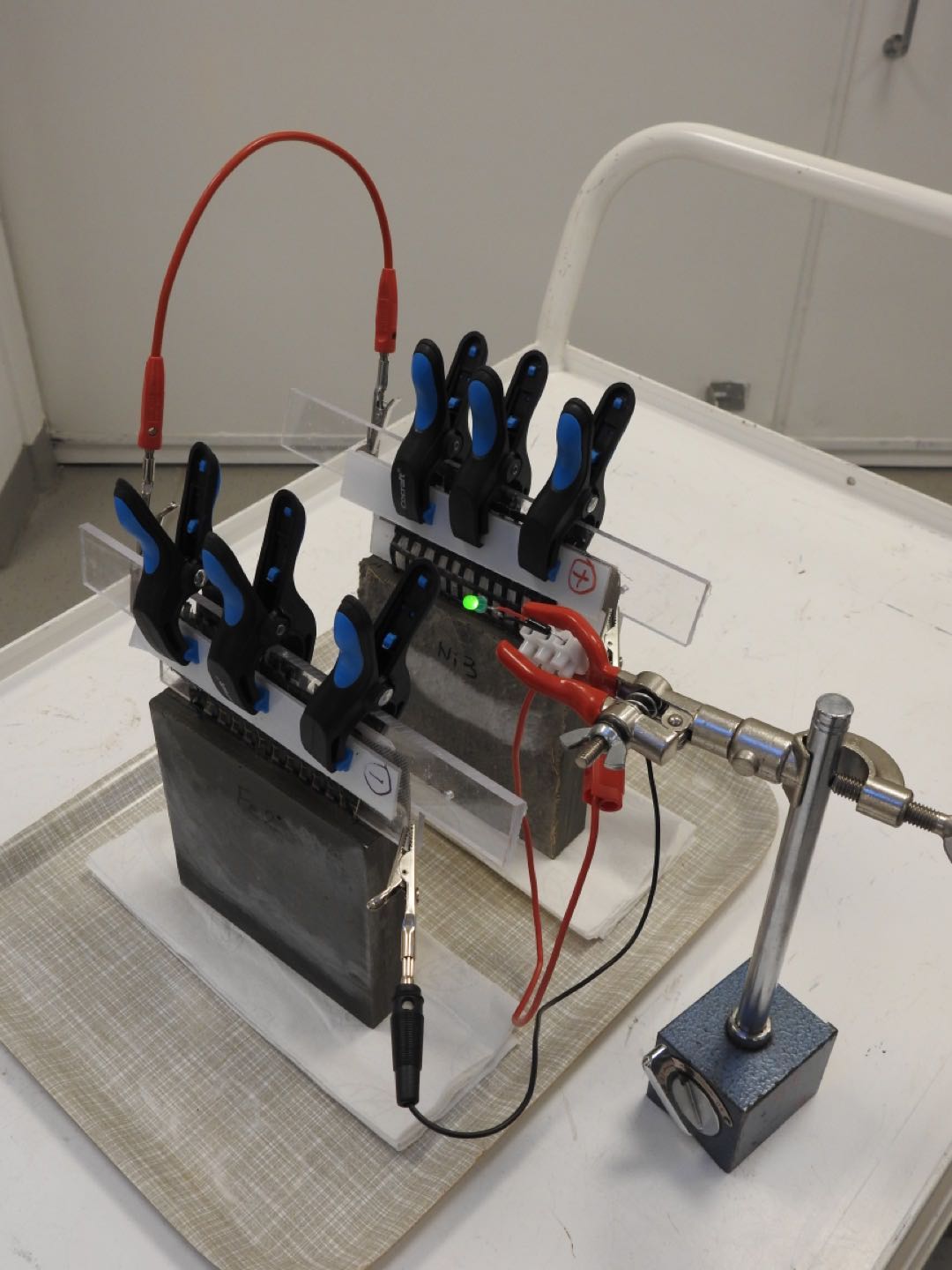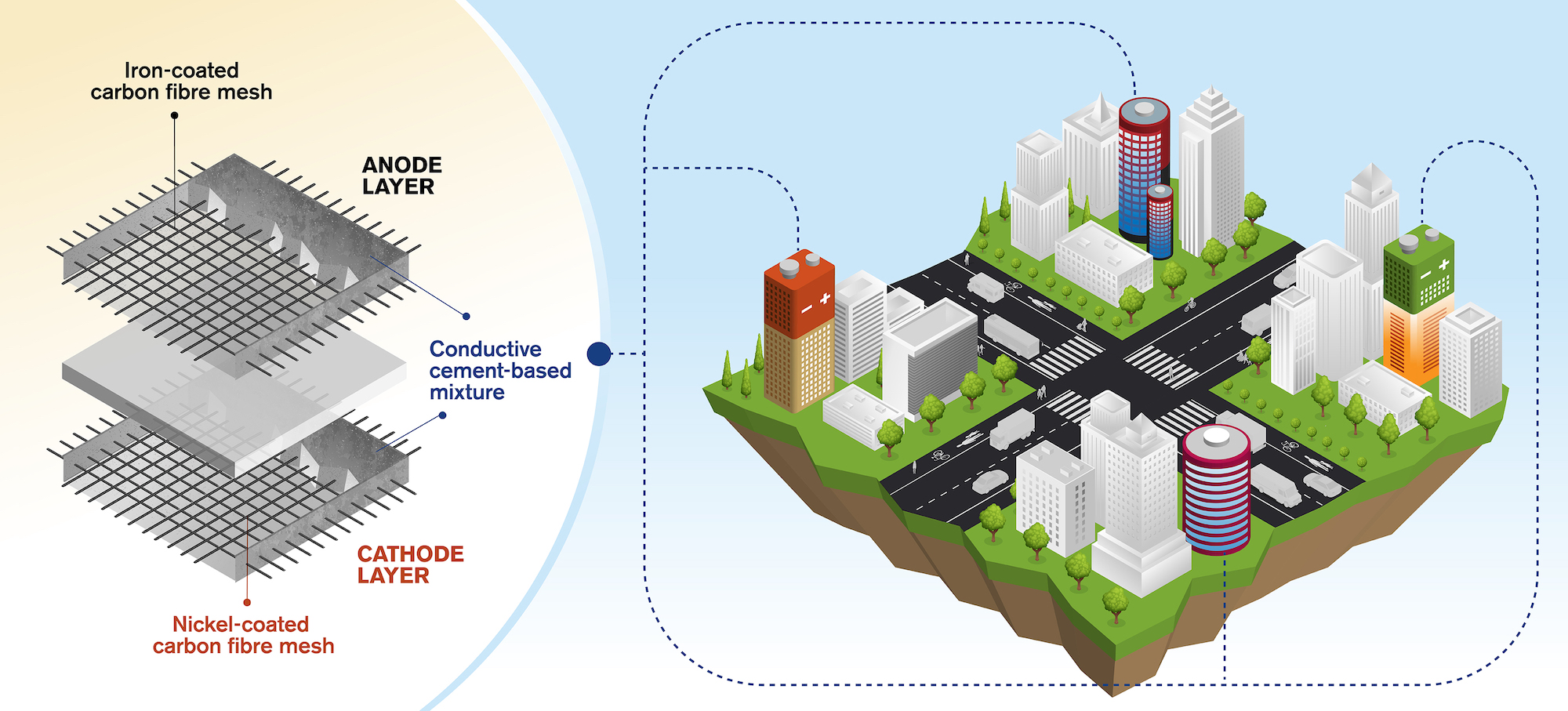Researchers from the Department of Architecture and Civil Engineering at Chalmers University of Technology in Gothenburg, Sweden, have created a concept for rechargeable batteries made of cement.
The concept involves a cement-based mixture with small amounts of short carbon fibers added to increase conductivity and flexural toughness. Embedded within this mixture is a metal-coated carbon fiber mesh—iron for the anode and nickel for the cathode. Several combinations for the electrodes were tested before the iron anode and nickel-based oxide cathode were found to yield the best results. Additionally, researchers had to experiment with different ratios of carbon fiber before finding an optimal mixture of around 0.5% carbon fiber to improve the cement-based mixture’s conductivity for the electrolyte.
The resulting cement-based battery has an average density of 7 watt-hours per square meter during six charge and discharge cycles—low in comparison to commercial batteries, but still potentially very beneficial to the built environment considering the large volume at which the battery could be constructed when used in buildings, bridges, dams, and other concrete structures.

The research team—led by Chalmers Professor Luping Tang and Emma Zhang, PhD, formerly with the university, now Senior Development Scientist at Delta of Sweden—envisions possible applications for the concept that range from powering LEDs, providing 4G connections in remote areas, and cathodic protection against corrosion in concrete infrastructure.
“It could also be coupled with solar cell panels to provide electricity and become the energy source for monitoring systems in highways or bridges, where sensors operated by a concrete battery could detect cracking or corrosion,” said Zhang.
Technical questions that need to be answered before commercialization of the concrete technology include extending the service life of the battery and the development of recycling techniques. The batteries would need to either be able to match the 50-100 year life of a typical concrete building or be made easier to exchange and recycle when their service life is over.
Despite these obstacles, the researchers are optimistic the concept has plenty to offer as a future building material that contributes to additional functions such as renewable energy sources.
Related Stories
Design Innovation Report | Apr 27, 2023
BD+C's 2023 Design Innovation Report
Building Design+Construction’s Design Innovation Report presents projects, spaces, and initiatives—and the AEC professionals behind them—that push the boundaries of building design. This year, we feature four novel projects and one building science innovation.
Design Innovation Report | Apr 19, 2023
Reinforced concrete walls and fins stiffen and shade the National Bank of Kuwait skyscraper
When the National Bank of Kuwait first conceived its new headquarters more than a decade ago, it wanted to make a statement about passive design with a soaring tower that could withstand the extreme heat of Kuwait City, the country’s desert capital.
Design Innovation Report | Apr 19, 2023
HDR uses artificial intelligence tools to help design a vital health clinic in India
Architects from HDR worked pro bono with iKure, a technology-centric healthcare provider, to build a healthcare clinic in rural India.
3D Printing | Apr 11, 2023
University of Michigan’s DART Laboratory unveils Shell Wall—a concrete wall that’s lightweight and freeform 3D printed
The University of Michigan’s DART Laboratory has unveiled a new product called Shell Wall—which the organization describes as the first lightweight, freeform 3D printed and structurally reinforced concrete wall. The innovative product leverages DART Laboratory’s research and development on the use of 3D-printing technology to build structures that require less concrete.
Cladding and Facade Systems | Apr 5, 2023
Façade innovation: University of Stuttgart tests a ‘saturated building skin’ for lessening heat islands
HydroSKIN is a façade made with textiles that stores rainwater and uses it later to cool hot building exteriors. The façade innovation consists of an external, multilayered 3D textile that acts as a water collector and evaporator.
Transportation & Parking Facilities | Mar 23, 2023
Amsterdam debuts underwater bicycle parking facility that can accommodate over 4,000 bikes
In February, Amsterdam saw the opening of a new underwater bicycle parking facility. Located in the heart of the city—next to Amsterdam Central Station and under the river IJ (Amsterdam’s waterfront)—the facility, dubbed IJboulevard, has parking spots for over 4,000 bicycles, freeing up space on the street.
Concrete | Jan 24, 2023
Researchers investigate ancient Roman concrete to make durable, lower carbon mortar
Researchers have turned to an ancient Roman concrete recipe to develop more durable concrete that lasts for centuries and can potentially reduce the carbon impact of the built environment.
Sponsored | Resiliency | Dec 14, 2022
Flood protection: What building owners need to know to protect their properties
This course from Walter P Moore examines numerous flood protection approaches and building owner needs before delving into the flood protection process. Determining the flood resilience of a property can provide a good understanding of risk associated costs.
Giants 400 | Nov 14, 2022
4 emerging trends from BD+C's 2022 Giants 400 Report
Regenerative design, cognitive health, and jobsite robotics highlight the top trends from the 519 design and construction firms that participated in BD+C's 2022 Giants 400 Report.
AEC Tech | Apr 13, 2022
A robot automates elevator installation
Schindler—which manufactures and installs elevators, escalators, and moving walkways—has created a robot called R.I.S.E. (robotic installation system for elevators) to help install lifts in high-rise buildings.















